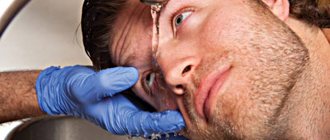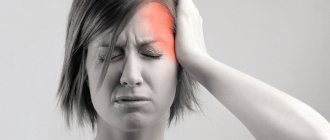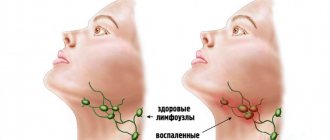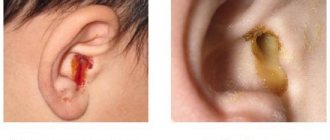Increased eye sensitivity to light is a fairly common problem. But it’s one thing when pain or pain occurs after leaving a dark room in the sun, and quite another thing when these things are completely unrelated to each other.
A disease called photophobia, or photophobia, can be chronic, or it can arise due to some phenomenon and go away if this phenomenon is eliminated. But first we need to find out exactly why the light began to cause discomfort.
Why ocular photophobia occurs, how to reduce it to nothing, and in what cases you need to run to an ophthalmologist - we’ll tell you in more detail.
Photophobia of the eyes: causes
This problem can occur due to a variety of circumstances, including the following:
- congenital features of the eyes - for example, people with albinism often suffer from this;
- working at a computer for a long time, in a room with poor lighting or dry air - all this puts strain on the eyesight;
- taking certain medications, especially those that dilate the pupils;
- heliophobia, that is, fear of the sun and the inability to go outside while it is shining;
- infectious diseases, ophthalmological diseases and problems with the nervous system;
- developmental abnormalities of the eyeball.
Sometimes the reasons are much simpler than they seem at first glance: for example, a child may develop photophobia because a grain of sand or other small foreign body got into his eye while playing. Then you just need to get rid of this interference - and soon the perception of light will return to normal.
Sometimes photophobia occurs after eye surgery - there is nothing wrong with that, you just need to follow the doctor’s recommendations and wait a little.
Photophobia symptoms
Photophobia can manifest itself in the following signals:
- squinting eyelids even in conditions of
In this article
Photophobia symptoms
- Causes
- Photophobia as a symptom
- Diagnosis and treatment of photophobia
dim lighting;
Photophobia is often accompanied by headache and dizziness, the effect of sand in the eyes, and a gradual deterioration in visual function. The presence of photophobia can be determined independently by these symptoms, but you should consult a doctor for an accurate diagnosis and prescription of corrective therapy.
Is it possible to avoid photophobia?
Quite if you take care of yourself. In most cases, photophobia in adults arises due to endless overwork, and then it is quite easy to protect yourself: you need to regularly do eye exercises, get up from the computer at least once an hour and, if necessary, consult a doctor who will prescribe eye drops that can lighten the load.
It is also important to wear sunglasses or wide-brimmed hats if daylight is too bright for you, and to have regular checkups with a professional.
What is photophobia?
Squinting from the bright sun or closing your eyes for a few seconds when leaving a dark room to go outside is a normal reaction of the body. As a rule, a few minutes are enough to adapt to different lighting. But people suffering from photophobia do not get used to bright light even after some time. Discomfort can be caused not only by the sun, but also by light from fluorescent and other lamps, as well as normal lighting, in which the eyes of a healthy person feel comfortable.
Sensitivity to light can be chronic, or it can be temporary, associated with some event, such as injury.
Contrary to the opinion of many patients, photophobia is not an eye disease as such, but a signal that a person has an eye pathology or a disease of the nervous system.
The following symptoms may often occur along with photophobia:
- Cutting, burning, pain or other discomfort in the eyes.
- Tearing.
- Desire to squint even in dim light.
- Increase in pupil diameter.
- Redness of the eyes.
- Decreased visual acuity.
- Dry eye syndrome.
- Tired eyes.
- Flashes, flies, floating dots, blurred vision.
Fear of light can also be accompanied by other symptoms (they depend on the disease that provoked photophobia). Among them:
- headache, migraine, dizziness;
- shortness of breath;
- nausea;
- pressing chest pain;
- sudden changes in mood, irritability, depression, aggressive behavior.
Regardless of the number of symptoms, we recommend consulting a doctor. Only a specialist can make the correct diagnosis, find the cause of photophobia and prescribe the correct treatment for the disease that provoked it.
Associated symptoms
Depending on what exactly triggered photophobia, it may appear along with various other symptoms, of which there are many. These include:
- redness;
- burning and itching;
- discomfort even from dim light;
- circles, dots and spots before the eyes;
- blurred vision;
- migraine;
- nausea.
Diagnosis and treatment of photophobia
Photophobia of the eyes cannot be treated without identifying and eliminating its cause. Ophthalmological specialists do not recommend self-diagnosis and self-medication, since the source of photophobia may be a serious illness that requires specialist intervention.
Diagnosis of fear of light
- Diagnostic conversation. The doctor determines at what moments photophobia of the eyes manifests itself, whether this damage is associated with exposure to sunlight, and whether the eyes react to artificial lighting. Additionally, the ophthalmologist clarifies the presence of concomitant diseases, finds out whether the patient takes medications, instills drops, etc.
- Ophthalmological examinations. Depending on the symptoms and general health of the patient, the doctor performs biomicroscopy, ophthalmoscopy, tonometry, and gonioscopy. The specialist may prescribe additional studies: ultrasound of the eyes, culture for bacteria, etc. Thanks to a thorough diagnosis, he can detect the source of infection, assess the condition of the anterior segment and fundus of the eye, the patency of the retinal vessels, etc.
- Neurological examinations. If photophobia is not associated with ophthalmological diseases, the patient is recommended to visit a neurologist, who may refer the patient for an MRI, Doppler ultrasound, or other examination.
Additionally, the ophthalmologist may recommend that the patient undergo examination by an endocrinologist, phthisiatrician or other specialist.
Treatment of fear of light
Photophobia can be treated immediately after diagnosis. Therapy usually includes:
- Treatment of the underlying disease. For example, a specialist can select medications to treat migraines, panic attacks, etc., prescribe drops to combat conjunctivitis, scleritis, dry eye syndrome, etc.
- Refusal of medications that provoke a fear of light, if this does not cause harm to health.
- Wearing sunglasses or photochromic lenses. The optometrist may recommend wearing them until the treatment produces results.
Diet for photophobia (photophobia)
Diet for eyes, nutrition to improve vision
- Efficacy: therapeutic effect after 2 months
- Timing: constantly
- Cost of products: 1800-1900 rubles. in Week
Nutrition for vision problems should be balanced and capable of providing the body with proteins, fats, carbohydrates, fluids, vitamins and microelements. Approximately the diet should consist of:
- various vegetables, fruits and dried fruits, berries, juices, compotes and herbal teas;
- meat, eggs, fish and seafood;
- porridge and whole grain baked goods;
- In this case, food is prepared by boiling, baking, using a steam or multicooker, seasoned with high-quality natural oils, sauces, herbs, seeds and nuts.
Rubella
Patients who have had rubella are often diagnosed with:
- catarrhal conjunctivitis together with entropion of the eyelids;
- catarrhal conjunctivitis, accompanied by punctate keratitis;
- retinopathy with concomitant swelling of the retina.
Rubella can provoke inflammatory reactions in the lacrimal glands, clouding of the cornea, and trigger degenerative processes in the retina. In pregnant women in late pregnancy it causes the development of congenital cataracts in the child, and in the early stages the death of the fetus.
General information
Photophobia of the eyes, or otherwise photophobia, is a painful sensitivity of the organ of vision to light and refers to subjective visual disorders. Contact with even the slightest rays can cause quite unpleasant sensations in a person, including pain and discomfort in the eyes, spasm of the eyelids, severe lacrimation, resulting in an urgent need to squint the eyes.
The cause of photophobia usually lies in various eye diseases, but it can also be caused by measles , rubella , meningitis , encephalitis , epilepsy , pathologies of the cornea and conjunctiva, which could be caused by erosive processes and superficial inflammation. In addition, there is a possibility of developing photophobia when using eye drops to dilate the pupils.
The most famous people with photophobia were Hannelore Kohl, Lyubov Orlova, Anna Wintour.
Pathogenesis
Hypersensitivity to any kind of light rays - natural or artificial - is usually a sign of disorders in the visual analyzer or nervous system - when the eye cannot perform its functions or the scheme of transmitting and processing information in the brain is disrupted. When a large amount of light hits the retina, neuroregulation must “give a command” that helps reduce contact with light so that the retina is not damaged, for example, narrow the pupil, close the eyelid, or an unconditioned reflex - involuntarily squint. If there are diseases or injuries to the organ of vision, the trigeminal nerve, or foreign bodies, then a “specific” negative reaction to light, even of normal intensity, may occur.
Diagnosis
Timely diagnosis of photosensitivity will increase the chances of quickly eliminating the fear of light and prevent the serious consequences of photophobia. For diagnosis, you should consult an ophthalmologist. He looks into the eyes and assesses their external condition, interviews the patient, and then, if necessary, prescribes an in-depth examination.
Photosensitivity may require the following diagnostic procedures:
- ophthalmoscopy to examine the fundus of the eye;
- biomicroscopy – study of the organs of vision with a special microscope with a slit lamp;
- tonometry - checking intraocular pressure;
- pachymetry – measurement of corneal thickness;
- perimetry – setting the boundaries of the real field of view;
- gonioscopy – analysis of the condition and structure of the corners of the eyes;
- Ultrasound of the visual organs;
- angiography – analysis of the integrity of the vessels supplying the organs of vision;
- corneal scraping, culture for viruses and bacteria to identify the causative agent of infection;
- optical tomography to detect structural changes in the retina;
- electroretinography, aimed at assessing the functioning of the retina;
- other research methods: MRI and CT, electroencephalography, Dopplerography, radiography.
Only after identifying the causes of photophobia and determining the factors that cause the eyes to react to light can we begin to eliminate photosensitivity and treat the underlying disease.
Photophobia in children
Most often, fear of light becomes an acquired disorder, but there are cases when it is congenital and is observed in children from an early age. For example, the reason for this may be albinism, color blindness, etc.
Photophobia in a child is a rather dangerous condition and can lead to the fact that it will be painful for him to look at the light, so parents need to ensure that their children have less stress, injuries, risk of infection, normalized use of electronic devices, optical instruments, compliance with hygiene standards, if necessary, correct vision correction, eye gymnastics.
Causes of the disease
To begin with, it should be noted that photophobia is a symptom of another disease, and not an independent nosological unit; for this reason, when identifying photophobia in patients, all efforts must be directed toward diagnosing the primary pathological process that led to sunphobia.
The causes of the disease can be different. So, these can be diseases (for example, conjunctivitis) or structural features of the eye (for example, albinism), general diseases (for example, colds or migraines), adverse environmental influences (for example, excess ultraviolet radiation).
It often happens that doctors may encounter congenital cases of photophobia, in which the eye reacts to daylight and artificial light due to a lack of pigment called melanin or due to its complete absence in the body.
In what cases is scleroplasty necessary and what contraindications are there for its use?
How to treat dacryocystitis can be found in this publication.
The main causes of cataracts, as well as about diagnostic and treatment methods, can be read at this address: https://viewangle.net/bol/katarakta/katarakta-simptomy-vidy-lechenie.html
In addition, taking certain medications can cause increased eye sensitivity to light. For example, to effectively diagnose the fundus of the eye, doctors instill drugs into the eyes that dilate the pupil, as a result of which it does not narrow under the influence of sunlight and, as a result, the retina is exposed to increased exposure to light rays.
Another cause of photophobia may be an adverse reaction to taking quinine, tetracycline, doxycycline, belladonna, furosemide.
In recent years, cases of photophobia associated with prolonged exposure to a computer (the so-called “computer vision syndrome”) have become more frequent, which is a consequence of the development of increased sensitivity of the eyes to wind and light against the background of visual stress and constant drying out.
Meanwhile, some diseases can also cause an aggravated reaction to light in the organ of vision:
- conjunctivitis (an acute or chronic inflammatory disease of the connective membrane of the eye)
- ulcers and corneal damage
- tumors
- keratitis (inflammation of the cornea of the eye)
- iritis (inflammation of the iris of the eye)
Photophobia can also occur as a result of damage to the eye by bright light (for example, snow ophthalmia, which implies damage to the cornea as a result of exposure to a large number of sun rays reflected from the snow; when welding without glasses, when looking at the sun, etc.) , retinal detachment and refractive surgery.
There are frequent cases of photophobia occurring during a migraine attack, with diseases of the central nervous system (meningitis, tumors) or during an acute attack of glaucoma. In addition, prolonged wearing of lenses (especially if they were incorrectly selected) can lead to increased sensitivity of the eyes to light.
Note that in rare cases, doctors have to deal with photophobia caused by botulism, mercury poisoning, chronic fatigue, and depression.
Symptoms
The symptoms of photophobia of the eyes are clearly defined by the very name of the pathology: eye intolerance to bright light. In this case, increased sensitivity and reaction of the eye to light can be caused by natural and artificial light sources.
The clinical picture of photophobia consists of the following signs:
- spasms (or convulsive closure) of the eyelids
- headache
- lacrimation
- Pain in the eyes
What is a spasm of accommodation, types, symptoms, treatment.
The most effective methods for treating stye on the eye, as well as possible complications, can be found in this publication.
Diphtheria
With a weakened immune system, the human body cannot cope with the diphtheria bacillus, which leads to the development of diphtheria. When bacteria penetrate into the conjunctival cavity, ophthalmic diphtheria develops, which can occur in three forms: membranous, catarrhal, and toxic.
Membranous diphtheria is accompanied by clearly visible swelling of the eyelid, purulent-turbid discharge from the eyes, pinpoint infiltrates, and the formation of a grayish film on the conjunctiva. If you remove the film, a bleeding surface will begin to form in its place. After the film is independently rejected, scars form in its place. In severe situations, the conjunctiva can fuse with the eyeball.
Toxic diphtheria manifests itself:
- swelling of the eyelids;
- bloody and purulent discharge;
- formation of filmy membranes;
- irritation of the skin around the eyes.










